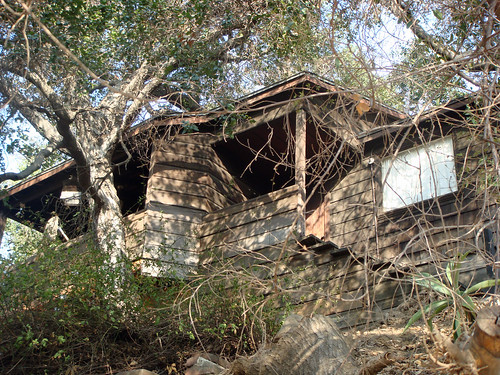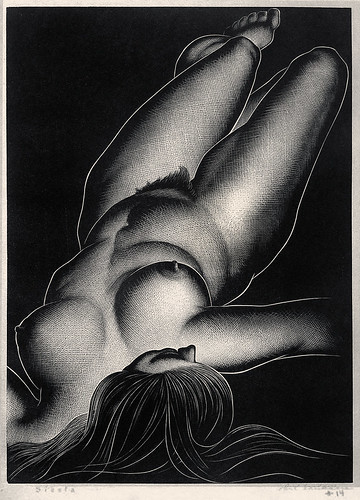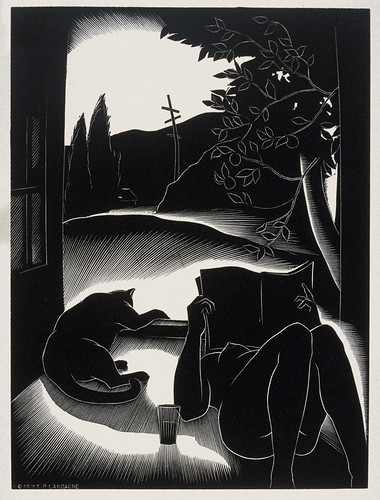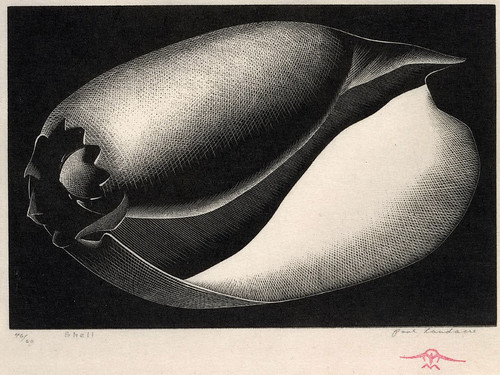Paul Landacre (1893-1963)
Paul Hambleton Landacre (9 July 1893, Columbus, Ohio - 3 June 1963, Los Angeles, California) was one of the outstanding printmakers of the modern era. His distinguished body of work was largely responsible for elevating the wood engraving to an art form in twentieth-century America. Landacre's linocuts and wood engravings of landscapes, still lifes, nudes, and abstractions are celebrated for their technical virtuosity and mastery of design.
Biography
Paul Landacre's indomitable spirit figures prominently in his storied career as an award-winning wood engraver. His early promise as a track and field athlete at Ohio State University was clipped by a debilitating polio-like illness, spurring him to leave Ohio in 1917 for the more healthful climate of San Diego. He soon resettled in Los Angeles where his diligence and good fortune recast his professional prospects as a budding commercial draftsman. In 1925, Margaret McCreery, an advertising copywriter he met a few years earlier, became his lifelong companion and wife, fully complicit in the brilliant realization of his artistic prowess.
Although he took some life-drawing classes at the Otis Art Institute between 1923 and 1925, Landacre largely taught himself the art of printmaking. He experimented with the technically demanding art of carving linoleum blocks and, eventually, woodblocks for both wood engravings and woodcuts. His fascination with printmaking and his ambition to make a place for himself in the world of fine art coalesced in the late 1920s when he met Jake Zeitlin. Zeitlin's antiquarian bookshop in Los Angeles (a cultural hub that survived into the 1980s) included a small gallery space for the showing of artworks, primarily prints and drawings, and it is there in 1930 that Landacre was given his first significant solo exhibition. Zeitlin's ever-widening circle of artists came to include Edward Weston, a photographer who shared the modernist vision that so captivated Landacre. Well-connected to the New York art scene, Zeitlin associated himself with the circle of artists represented by Carl Zigrosser, director of the Weyhe Gallery in Manhattan and, later, curator of prints at the Philadelphia Museum of Art. By 1936 Zigrosser considered Landacre to be "one of the few graphic artists worth watching" in America, and included him among his portraits of 24 contemporary American printmakers in his seminal work, "The Artist in America" (Knopf 1942). Elected a member of the National Academy in 1946, Landacre was honored in 1947 with a solo exhibition of his wood engravings at the Smithsonian Museum, its graphic arts division under the curatorial leadership of Jacob Kainen.
Of national and local appeal, many of Landacre's linoleum cuts and wood engravings were inspired by the American Far West, including the hills and mountains of Big Sur, Palm Springs, Monterey, and Berkeley. "California Hills and Other Wood Engravings by Paul Landacre" (Los Angeles: Bruce McCallister, 1931), a limited-edition folio comprising 15 of Landacre's early works printed from the original blocks, was awarded recognition as one of the "Fifty Books of the Year" for 1931. In rapid succession, three more books illustrated with his wood engravings also garnered such recognition: "The Boar and the Shibboleth" (1933), "A Gil Blas in California" (1933), and "XV Poems for the Heath Broom" (1934). In the 1950s, when the AIGA recognized "A Natural History of Western Trees" (1953) and "Books West Southwest, Essays on Writers, Their Books and Their Land" (1957) as "Fifty Books of the Year", they became the fifth and sixth books Landacre illustrated to win the prestigious award. For "Trees" Landacre contributed more than 200 ink drawings on scratchboard, a multi-year devotion to arboreal beauty.
As his artistry evolved, Landacre developed a singular style lauded for its formal beauty—meticulously carved fine lines, delicate cross hatching, and flecking—elements in white which strikingly contrast with richly blackened areas. He used the finest inks and Japanese papers and, with few exceptions, printed his wood engravings on a Washington hand press—now in the collection of the International Printing Museum in Carson, California. His prints, including the early linocuts, gained early and lasting critical recognition, were awarded numerous prizes, and can be found in more than a hundred and fifty public collections throughout the United States.[1]
In March 1932, the artist and his wife moved to a rustic house in the Echo Park neighborhood, also known as Edendale, near downtown Los Angeles, where they lived for the remainder of their lives. Landacre died in 1963 soon after—and emotionally resulting from—the death of his wife who had been an essential working companion for 38 years, even helping the artist late in his life pull impressions from the formidable Washington hand press. In March 2006, with the growing appreciation of Landacre's artistic significance, their hillside home was declared a City of Los Angeles landmark (Historic Cultural Monument No. 839).
(http://en.wikipedia.org/wiki/Paul_Landacre)
Paul Landacre
 |
| Sultry Day
|
 |
| Lot Cleaning |
Paul Landacre was the preeminent American wood-cut print artist of the 20th Century. Landacre's work reflected not only the character of the California landscape, but particularly in the 1930s; the character of his own Echo Park neighborhood. His style was clearly influenced by the natural beauty and dramatic quality of light in his own neighborhood. In fact, the neighborhood was often the subject of his work.
Right: Lot Cleaning, 1935, Landacre comments on the City's practice of setting fire to the hillsides for brush clearance. Landacre wrote numerous letters to the local newspapers, presented a petition to City Council and created the prize winning print in protest of the City's policy.
Below: Sultry Day, 1937 depicts wife and cat at his beloved home with the intersection of Modjeska Ave. and Peru St. in the background.
Landacre worked out of his home on El Moran Ave. in the Semi-Tropic Spiritualists' Tract for more than 30 years, until his death in 1963. Landacre's cabin, the grounds around his cabin and the hillside of the tract retain the same rural character that existed when Landacre created his unique works of art. It's a place where the natural beauty and quality of light still inspire artists today.

Paul Landacre Cabin, 2006 El Moran
Street, Sept 5, 2005 (photo by Charles J. Fisher)
Paul Landacre Cabin, Los
Angeles Historic Cultural Monument
#839
Declared March 17, 2006
This house was constructed in the heavily
wooded Semi-Tropical Spiritualist Tract in 1909 as a small mountain cabin in the
country. The house was purchased in 1932 by modernist landscape artist and
woodcarver, Paul Landacre, and his wife, Margaret. It was in this wooded
enclave, surrounded by California Live Oaks and other native vegetation, that
Landacre produced most of his best work. Using the medium of wood blocks to
produce his highly acclaimed black and white prints, Landacre's work is
considered the best of his era, as he was acclaimed as the undisputed master of
the wood block technique. His many patrons included Mrs. E. L. Doheny and Mrs.
Samuel Goldwin. Landacre's work is exhibited at many prominent art museums
including the Los Angeles County Museum of Art.
|
 |
| Photo: Andrew Sears |
(...) Paul Landacre wrote about his life in the Echo Park hills in 1958, not so different from those who live in the Semi-Tropic Spiritualists' Tract today;
"You see, art is practiced here along with various other concerns -pruning trees, repairing the roof, watching and feeding wildlife and so on. Of course, other artists live on wooded hillsides, too, and so do other people, and it must be conceded that to some of us this kind of environment is not only valuable, but absolutely necessary - a degree of seclusion, the life of growing things, awareness that we are a part of nature."
Landacre carved a petrel, his signature bird into the roof vents on each side of his house. He used the petrel as his trademark on his work, often in place of his signature.
Landacre struggled with physical disabilities most of his life. He identified with the petrel since they learn to fly by jumping off a cliff; falling into the raging sea; hurling themselves off the peaks of waves until they learn to fly. They crash into the rocks and waves, beat up, but they learn to fly.
(Paul Landacre escribió sobre su vida en las colinas de Echo Park en 1958, no tan distinta de los que viven hoy en Semi-Tropic Spiritualists' Tract;
Landacre había tallado un petrel, su pájaro de firma en las rejillas del techo en cada lado de su casa. Usó el petrel como su marca registrada para su trabajo, a menudo en lugar de su firma.
Landacre luchó con sus discapacidades físicas la mayor parte de su vida de su vida. Se identificaba con el petrel ya que éste aprende a volar saltando de un acantilado; cae al mar embravecido; choca contra las rocas y las olas pero aprende a volar.)















No hay comentarios:
Publicar un comentario